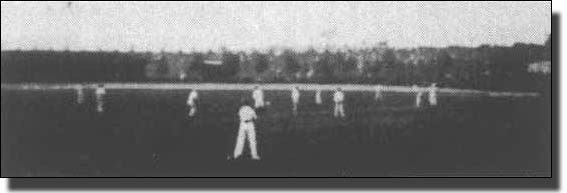The Birth of Paddington Recreation Ground
In the 1880s, building works began to engulf the area. Each year Paddington Cricket Club found it more and more difficult to find cricket fields to play on, as fields which they had used for decades disappeared under houses. Half of Saturday was spent travelling to distant grounds, while evening practice became impossible.
Mr R.M. Beachcroft, Secretary of the Paddington Cricket Club, the largest in the area, took the initiative and invited all local clubs to a meeting to discuss the creation of a local cricket ground. The meeting resolved that:-
'in the view of the still growing extension of London, it is essential that steps should immediately be taken to secure for Paddington a ground available for cricket and other forms of outdoor recreation.’ The ground chosen was 'the open spaces which were as yet un-built upon in the north west extremity of the Borough.' |
This was the then vacant land between Shirland and Portsdown Roads. It had long been regarded as a possible site for a public park, but the Bill promoted in Parliament in 1882 had failed because of the rating proposals.
A committee of prominent people was formed. The land was owned by two public bodies, the Ecclesiastical Commissioners and the Paddington Estate Trustees. These bodies agreed on the sale price but not on how it should be divided between them. The project almost foundered but Beachcroft took full responsibility on himself. He would rent, as yearly tenant, about nine acres from the occupier of the land, quite certain, as he himself expressed it, that
“when it came to the point of his being dispossessed, a final struggle would be made to secure the land as a playing field for the parish.” |
He knew it was a gamble and this insecure position continued for some time. Other vacant plots in the neighbourhood were being built upon one after the other. The short Elgin Road of 1868 had become Elgin Avenue, extending right across to the Harrow Road, so the threat of further development was always present.
The ground had been used earlier for sports. The employees of William Whiteley's, Liberty's and other firms had used it for cricket and tennis. It had been the first roller skating rink and lawn tennis ground in London. A corrugated iron building had been erected to protect the skaters and when skating declined in popularity, the concrete rink was converted into tennis courts. But conditions were far from ideal. A local contractor, Mr Boyer, had dumped there untold loads of brickbats and clinker. In the second phase of development, these would become hardcore for the cycle and ruining tracks, while the remainder would be collected into a huge heap and turfed over to make The Mound, one of the most pleasant features of the present ground. By 1887 they had achieved only the cricket pitch.

The Cricket Pitch
